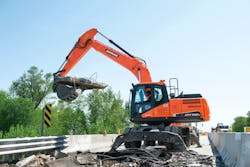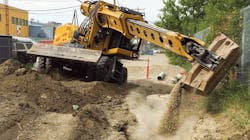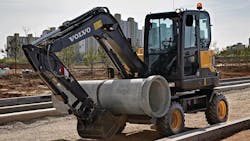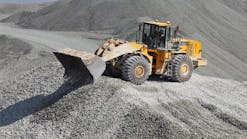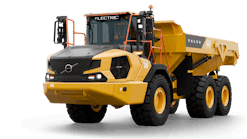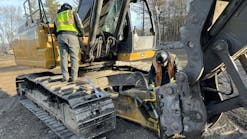Just like with any product, managers considering wheeled excavator purchases need to weigh operating costs as a key driver in the buying decision.
Maintenance, the use of telematics, monitoring fuel burn, and operator training are some of the cost-reduction keys mentioned by wheeled excavator manufacturers.
“The best way to keep operating costs to a minimum, while also getting the highest return on your equipment investment, is to provide ongoing service and maintenance to your machines,” says Michael Norman, director of sales and marketing for Gradall.
“You can optimize the productivity and working life of your excavator by keeping your machines on a regular service schedule and addressing maintenance issues in a timely manner. A smoothly working machine is the most efficient and money-saving tool on the job site.”
Mike Fuller, senior product manager for Hyundai excavators, stresses using telematics technology for maintenance and cost reduction.
“Outside of having a scheduled PM plan internally or with your dealer and making sure you train your employees on best operation practices, you’ll also need reliable telematics you can trust,” Fuller says. “Our HiMate proprietary remote management GPS technology system lets customers program our automatic engine shutdown/one-touch auto decel for huge fuel savings, and also lets them know when needed services are close, or in some cases overdue. It’s a must.”
Matthew McLean, product manager for Volvo excavators, also agrees on telematics.
Machine data control excavator costs
“Managers can keep operating costs down by making good use of telematics,” he says. “The problem for many of them is that their telematics program overwhelms them with data and doesn’t provide insights. That’s why Volvo developed ActiveCare Direct. Instead of owners and managers sifting through thousands of data points, ActiveCare Direct does it for them and alerts them when immediate attention is needed, providing the probable cause, a recommended solution, and the potential consequences of not acting. Our system also provides monthly fleet reports, giving owners and managers information they can use to optimize fleet utilization, improve uptime, and reduce operating costs. ActiveCare Direct is available on several of our wheeled excavator models,” McLean says. (Read more about the ActiveCare model in the article on Construction Equipment Dealer Excellence Award winner Tyler Equipment.)
“You can also tell how long the machine has been idling, and while in use, how efficiently it’s being used, as reports are available to both the dealer as well as the contractor,” Hyundai’s Fuller says, of telematics. “This not only saves on additional fuel costs, but it will also extend the life of the machine.”
Fuller also says his HiMate system can “fine tune” the machine to best fit a wide range of operators for maximum efficiency and minimum fuel burn.
Chris Lucas, product manager for JCB excavators, also focuses on operators and fuel burn. “I always recommend to my customers to find the rpm that works for them and is suitable to the task they are performing, set it, and leave alone. You can also adjust your auto-idle to support this.
“Many times, you will see operators running the machines at full throttle when it’s truly not necessary,” Lucas says. “[Adjustments] can help save fuel and reduce significant wear on the engine and hydraulic pumps. Additionally, you should keep to your suggested guide on oil-change increments and part replacement/lifespans to ensure you are keeping your machine running to its optimum level. Not doing these things can negatively impact the life of the unit and the cost for daily operations, not to mention the counter result of not completing a job.”
Managers should pay special attention to training operators on work modes, once again to try to defeat operators’ tendencies to go “all out.”
“A big one is to train operators on an excavator’s work modes, which can help reduce fuel costs,” says McLean. “Many operators tend to select the highest setting available, regardless of task. Often, however, the task could be achieved at a much lower rpm without any loss in performance or cycle times. Another tip related to fuel is to use built-in fuel-saving features like auto idle and auto engine shutdown.”
Matt Santee, product application specialist for Caterpillar excavators, reiterates that managers can save money by watching fuel use.
“While fuel consumption is one of the least talked about [factors], it can have one of the largest impacts on a machine’s operating costs,” Santee says. “It’s often not talked about because it isn’t tracked down to the serial number level. When a machine needs fuel, it drives to the fuel barrel, refuels, and it is on its way. With a [Cat] next generation wheeled excavator, customers will find themselves going to the fuel barrel less.
The reduction in fuel consumption can be attributed to use of an electro-hydraulic control system, according to Santee. “This system provides complete integration on-board to ensure the machine acts upon an operator’s command in the most efficient way possible,” he says. “This deep level of system integration allows us to provide industry-leading fuel efficiency.”
Santee offers an eye-opening statistic on idle time, as well. “Reducing idle time can significantly reduce your operating cost and most importantly improve your bottom line,” he says. “The average idle time on an excavator in North America is 30 percent. That means nearly a third of its life is spent consuming unnecessary fuel—and warranty hours.
“One technology we offer standard on our wheeled excavators to manage idle time is automatic engine idle shutdown,” Santee says. “The system allows a manager to input a given time interval, appropriate to the operation, that a machine can idle before it automatically shuts down. A great way for a customer to benchmark where they are today with idle time is to look at their fleet via a telematics application such as VisionLink.”
Aaron Kleingartner, dealer and product marketing manager for Doosan excavatos, keys back on maintenance, stressing the importance of a visual inspection.
“For wheel excavators, operators should inspect tire pressure, wear, and damage on a regular basis. These are detailed in the owner’s operation and maintenance manual,” he says. “A visual inspection will show if the tire has tread punctures or sidewall damage because of road hazards. Also, look for rocks wedged in between dual tires, which can cause tire failure. Steel spacer rings prevent rocks from entering in between tires, but it is still important to visually check the tires before use.”
Many of the latest technological advances on wheeled excavators revolve around maintenance, telematics upgrades, productivity features, and visibility. Here’s a brief sampling of some of the most recent.
Caterpillar introduced two new wheeled excavators during Conexpo. “The latest piece of technology I’m most excited about on our next generation wheeled excavators is remote flash and troubleshoot,” Santee says. “Remote flash updates on-board software without a technician being present, seamlessly bringing new features and functions to the machine. Remote troubleshoot allows a Cat dealer to perform diagnostic testing on machines remotely, pinpointing potential issues while the machine is in operation. Remote troubleshoot ensures the technician arrives with correct parts and tools the first time, eliminating additional trips to save customers time and money.”
Doosan points to enhancements to its DoosanConnect telematics system that managers can use to keep tabs on operator behavior. “Fleet managers can remotely monitor wheel excavators with the system,” Kleingartner says. “Another benefit of the system is monitoring operators and their machine usage. Managers can see how much operators are using the machine during a shift. If an operator is idling the machine and burning diesel fuel, managers can counsel the operator to reduce idle time and save fuel. In other words, telematics can help with operator training and best practices to improve a company’s profitability.”
Volvo points to several technologies available on its North American models.
“One of the most valuable technologies found on many of our excavators is Volvo Dig Assist,” McLean says. “This machine-control system lets operators input job site specifications and shows them real-time information on the Co-Pilot in-cab display, helping operators level, dig, and grade much faster, easier, and safer. Incorporating sensors and GPS technology, Dig Assist delivers accuracy in a fraction of the time normally taken using conventional methods.
“Smart View is another technology that maximizes visibility thanks to front, rear, and side cameras providing a real-time, overhead view of the machine during operation,” McLean says.
Visibility is also the hallmark of one of the latest Hyundai systems.
“Looking at the records of the United States Department of Labor Occupational Safety and Health Administration, two of the four fatal death causers are ‘Struck by Object,’ 112 individuals, or 11.1 percent, and ‘Caught-In/Between,’ 55 people, or 5.5 percent,” Fuller says. “This means an average of 167 workers in the year 2018 alone were killed by two of the fatal four. A good portion of these were where people were struck or run over by a piece of machinery.
“Our AAVM (All Around View Monitoring) system, gives a 360-degree birds-eye view around the machine, which greatly protects workers on the job site,” Fuller says. “Not only by sight, but [also because] Hyundai’s AAVM is equipped with IMOD, or Intelligent Moving Objects Detection. This alerts the operator to the presence of anything within a 16.5-foot range of operation via an audible alarm and color changes via the 8-inch full-color monitor.”
JCB’s Lucas points to a particular feature on its Hydradig. “At JCB, one we hold unique is ‘Reverse Steer,’” he says. “Reverse steer allows the operator to change the driving direction from the front to the rear. This allows for the machine to be driven as normal regardless of which way you are facing. Turning right will always be the operator’s right, even when the operator is seated facing the rear of the machine. This removes confusion for the operator and makes the machine user- friendly for all skill levels. It also increases efficiency by letting the operator drive naturally.”
Traditionally, wheeled excavators have been more popular in Europe than the U.S., but acceptance here is gaining.
“The market for wheel excavators has remained relatively flat in the United States and Canada,” says Doosan’s Kleingartner. Doosan markets three models in North America. “While there has been an increase in smaller wheel excavator sales, the larger model sales are still low. A majority of contractors prefer using tracked excavators for traditional earthmoving applications. In some more congested areas of the United States, such as the northeast, there has been an increased adoption rate of wheel excavators. Contractors there use wheel excavators on concrete and asphalt where the tires minimize disturbance to the finished surfaces.”
Volvo’s McClean sees a shift starting in the U.S.
“Wheeled excavators are common in Europe but have taken a while to catch on in North America. They are starting to take hold here as contractors and government fleets increasingly recognize their versatility, mobility and speed, which is up to 22 mph on the road for Volvo wheeled excavators. They are now viewed as all-purpose machines that can be used in a lot of applications based on the configuration and attachments being used. For example, Volvo wheeled excavators, ranging from our EW60E compact model to the 22-ton EW220E, are used for landscaping, ditch maintenance, utility installations, material handling, general construction, and more. Another contributing factor has been their growing availability in North America.” Volvo now offers seven models.
“Taking a look at only the U.S. market and removing Canada from the equation, which declined 24 percent, the total U.S. market has only declined 17 percent,” Fuller says. “However, one-third of that market experienced significant growth in states like Florida, Georgia, Texas, Michigan, Massachusetts, Illinois, and Missouri. Especially in places like Florida, for example, much of this is attributed to large road construction projects that were ongoing and some were even accelerated to stimulate the economy. Georgia was another good example, as the Georgia DOT awarded $109.4 million in contracts from March bids.”
However, on the flip side of this good news also comes the bad.
“With Covid-19 becoming such an unprecedented event, this has certainly attributed to the majority of the decline we have seen thus far,” Fuller says. “With 2020 also being an election year, the uncertainty of the economy has taken a toll. Results of social distancing along with more people working remotely, created a significant decrease in the number of vehicles on the roads. This greatly affected revenues from fuel taxes and toll roads/bridges, which are an important source of funding for road improvement and maintenance projects. With this said, several U.S. states lost funding in their DOTs as a result. Some responded by delaying non-essential highway, bridge and street projects and treated resurfacing projects with patch and sealing.”
